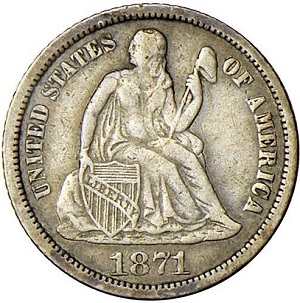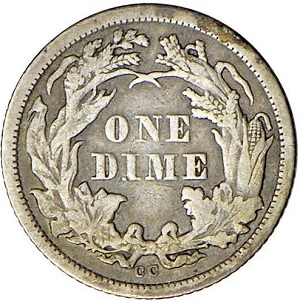1871-CC Seated Liberty Dime
The Seated Liberty design of Christian Gobrecht was first placed on the United States dime in 1837, and continued until 1891. In 1870, the legendary Carson City Mint began operations, with the production of quarters, half dollars, and silver dollars. The first Seated Liberty dimes were not coined at Carson City until 1871, when a paltry 20,100 were released.(1)
This came when pocket change was consumed quickly by a coin starved population living in the western United States at the time. Not many examples were set aside for future posterity.
It's hard for collectors today to understand their predecessors in the late 19th century paid little heed to mint marks. This began to change in 1893 when Augustus Heaton published A Treatise on Coinage of the United States Branch Mints, where he drew attention to the goal of obtaining examples from individual branch mints. Within a few years, collectors began to furiously compete for examples of the 1871-CC dime.
The problem for them, and for modern day numismatists, is that there simply were not enough extant pieces to meet demand. From the original mintage, only 110 are estimated to remain today,(2) for a survivorship rate of 0.5%. Because of the low supply/high demand ratio, prices have consistently moved higher and at a faster pace than most collectible coins for a very long time.
Fascinating Fact 1: An analytical tool used by coin experts to foil alteration fraudsters is that the edge reeding on the Carson City dimes from 1871 are wider (meaning a lower reed count) than their Philly and San Francisco counterparts.(3)
Fascinating Fact 2: Only a single reverse die was used to strike all the “CC” dimes from 1871 to 1874.(4) Tiny mintages for those years made that possible.
The 1871-CC Seated Liberty Dime is rare in any condition, is of historical significance, and is one of the most valuable key dates in the lengthy Seated Liberty dime series.
| Estimated survivors in all grades: 110 ?
The survivor estimate from PCGS represents an average of one or more experts' opinions as to how many examples survive of a particular coin in all grades. Survival estimates include coins that are raw, certified by PCGS, and certified by other grading services. Learn more at PCGS. |
| PCGS Rarity Scale: 7.9 ?
The 'PCGS CoinFacts Rarity Scale' assesses the relative rarity of all U.S. coins, based on estimated surviving examples. The scale runs from 1.0 to 10.0. The higher the number, the rarer the coin.
Learn more at PCGS. |
| Click HERE to check for availability on eBay** |
Preview of eBay selection (if no 1871-CC dimes in Preview, try HERE link above):
 |
 |
| Trendline Avg = 19.31 | BETTER |
Historic Value Trend Charts:
| Last updated 3-5-25 | Return to Key Date Coin List | |
| Compare to Common Date Coin of Same Type | ||
|
|
||
| Download Charts to Your Computer | ||
Sources
1. Stack's Bowers Galleries. 1871-CC Liberty Seated Dime. Aug 2012 Auction.
2. PCGS. 1871-CC 10C (Regular Strike).
3. Stack's Bowers Galleries. 1871-CC Liberty Seated Dime. Aug 2012 Auction.
4. Heritage Auctions. 1871-CC 10C. Oct 2014 Auction.
**Many very fine coin dealers sell on eBay. At any point in time, there may be over one million search results for United States coins. This includes quite a few of the recommendations on our Key Date Coin List.
If you’re thinking about purchasing a rare coin, eBay is certainly worth a look. For your convenience, the links from this site to eBay are coded to bring up only coins certified by PCGS and NGC.
As is always, always the case, never buy a valuable coin from a seller whose trustworthiness cannot be verified. Learn more about this at our chapter Best Places to Buy Coins, which also has a section on doing business on eBay.
In the interest of full disclosure, Rare Coins 101 receives a small commission anytime someone connects to eBay from this site and purchases something.
Coin images by Stack's Bowers Galleries.


